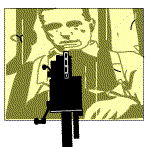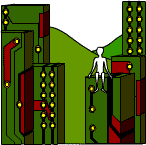Blade Runner - A Classic?
Created | Updated Jan 28, 2002
Love it or loath it, Blade Runner is undeniably one of the major cult classics of the late twentieth century.  However, upon release in 1982 you could have been forgiven for thinking that this would be one of the biggest film failures of the decade. After months of highly publicised fights on the set, script changes and overspending, Ridley Scott1 finally finished directing his $28million futuristic science-fiction thriller, only to have it globally panned by audiences and critics alike. So much so that the end of the film had to be completely changed in order to appease studio bosses and ever dwindling audiences. Whilst these last minute changes destroyed Ridley's initial vision they did nothing to further entice audiences into the film and after comments such as "Blade Runner is a spectacularly nasty film", it attracted barely enough viewers to regain half its production costs 2 and thus quietly disappeared from cinemas. Yet behind all this negativity, Blade Runner was slowly being discussed among science fiction circles and with the re-release of Ridley Scott's original 'Directors Cut' by Warner Brothers in 1992 the film became recognised as the definitive cult classic which is still delighted in today.
However, upon release in 1982 you could have been forgiven for thinking that this would be one of the biggest film failures of the decade. After months of highly publicised fights on the set, script changes and overspending, Ridley Scott1 finally finished directing his $28million futuristic science-fiction thriller, only to have it globally panned by audiences and critics alike. So much so that the end of the film had to be completely changed in order to appease studio bosses and ever dwindling audiences. Whilst these last minute changes destroyed Ridley's initial vision they did nothing to further entice audiences into the film and after comments such as "Blade Runner is a spectacularly nasty film", it attracted barely enough viewers to regain half its production costs 2 and thus quietly disappeared from cinemas. Yet behind all this negativity, Blade Runner was slowly being discussed among science fiction circles and with the re-release of Ridley Scott's original 'Directors Cut' by Warner Brothers in 1992 the film became recognised as the definitive cult classic which is still delighted in today.
WHAT IS BLADERUNNER?
This film described as
"visually stunning yet frightening in its bleakness"is loosely based around Phillip K Dick's 1968 novel 'Do Androids Dream Of Electric Sheep?'. Set in the year 2019, it follows the story of Los Angeles detective, Deckard, being called out of retirement by his old boss Bryant in order to "retire" an escaped group of artificially created humans known as "Replicants", which were manufactured by the Tyrell Corporation. The film follows Deckard's struggle not only to recapture and kill the replicants using a specially designed Voight-Kampff test, but also to rediscover his own humanity after a surprising twist in the tale leaves Deckard wondering about his own origins.
THE CHARACTERS.
DECKARD - "Sushi? That's what my ex-wife called me. Cold Fish."
Rick Deckard (Harrison Ford) is the typical Film Noir detective from his frequenting of seedy bars and apartments, right down to his long brown trench coat and stubble. Deckard is an ex Blade-Runner, reluctantly employed to track down and destroy an escaped colony of replicants within Los Angeles. However, through this unwanted assignment, the previous misogynist divorcee falls in love with Rachael, one of those who he was sent to kill and through this untraditional relationship Deckard slowly begins to learn more about himself than ever before and possibly more than he wanted to know. It is this relationship which provides the first blatant mention of the possibility that Deckard himself may be one of those he is employed to kill. Rachael raises the possibility that his humanitarian sympathy for the replicants struggle for survival is based upon a forced bond of kinship when she asks the male protagonist whether he ever took the Voight-Kampff test himself.
RACHAEL - "I'm not in the business, I am the business."
Rachael (Sean Young) is first introduced to us when Deckard visits the Tyrell Corporation in order to persuade its owner, Tyrell, that he can recapture the replicants by using a devise known as the Voight-Kampff test. It is this test which first alerts us to the fact that rather than the high ranking employee of the corporation, as we are led to believe, Rachael is in fact one of Tyrell's guinea pigs, a replicant designed to be "More Human than Human." Rachael's own ignorance to her replicant origins are a cause of initial disgust to Deckard who ironically ponders "How can it not know what it is?" Like Deckard, Rachael is a typical film noir character mimicking the perfect doll like beauty of film noirs traditional leading ladies whilst at the same time representing the one truly strong woman within the film. However, as the film progresses we realise that this strength and coldness is pre-programmed in her. Once she is persuaded by Deckard that she is a replicant she ironically becomes more human than ever before, falling in love and gradually becoming less animal like in both appearance and emotion.

ROY BATTY - "I've seen things you people wouldn't believe. Attack ships on fire off the shoulders of Orion. I watched C-Beams glitter in the dark near the Tannhauser gate. All those moments will be lost in time, like tears in rain."
Batty (Rutger Hauer) is the leader of the escaped replicants and through his own need for the answer to survival 3 he crosses Deckard's path and becomes entangled in a battle where either he or Deckard alone can survive. To start with this seems to be a battle of wits but by the closing moments of the film we are witnessing a battle for humanity, which creates one of the most poignant and memorable moments of the whole film. Batty himself is a combat model replicant who is portrayed on a superficial level as the 'baddie' within the film yet on closer analysis we realise that everything he does is driven by his intense passion for life and his love for Pris (Daryl Hannah) another replicant.
GAFF - "You've done a man's job, sir"
Gaff is one of the most enigmatic characters within the film, always appearing out of the shadows whenever a replicant has been retired yet never obviously present. His role seems to be as another Blade Runner but one who has never been as good as Deckard. Thus, throughout the film he plays the role of dogsbody, continually taunting Deckard with origami models representing his weaknesses.
PRIS - "I think, Sebastian, therefore I am."
Pris is the other main female character within the film, like both the other females she too is a replicant and plays Batty's love interest within the film. Described by Bryant as "yer typical pleasure model", she uses her charms to persuade Sebastian that she is a friend who can be trusted in order to gain access to Tyrell and therefore, the key to her survival.
JF SEBASTIAN - "I make my friends"
JF is a geneticist with the Tyrell corporation who has remained on earth due to a genetic disorder which prevents him from travelling to the off world colonies. One of Tyrell's most trusted employees, Batty and Pris seek him out in order to discover how to remove their 4 year life spans. Much of the second half of the film takes place in JF's apartment building and the final battle between Deckard and Batty occurs here.
BRYANT
Bryant is Deckard's Boss, the head of the LA police force. He is a cold and uncaring figure who is scruffy, immoral and bigoted, showing deep hatred for all replicants. Ironically, in viewing all replicants as inhumane machines, Bryant displays all the characteristics and lack of emotions which he seems to hate in others.
ZHORA
A minor character who appears only briefly within the film but one who epitomises everything which Deckard finds hard about his job, displaying fully the replicants struggle for survival.
SO IS HE HUMAN?

One of the greatest debates surrounding Blade Runner relates to whether or not Deckard himself is a replicant and this is the reason why he has such difficulty retiring the replicants.
THE EVIDENCE - "...At the end, he wanted the audience to find out that Deckard was a replicant."
Possibly the main evidence in support of Deckard being a replicant is Ridley Scott's confirmation that this was his original idea. Whilst clearer to see in the Directors Cut where the unicorn and eye symbolism is still intact, all versions provide many hints as to Deckard being a replicant.
- Gaff follows Deckard everywhere and is continually present as soon as a replicant has been retired. It has therefore been suggested that Gaff is the real Blade Runner and Deckard is merely his tool for the job
- Eye symbolism is rampant throughout the film, used by the Voight-Kampff test to identify replicants, it takes on greater meaning with reference to Deckards own identity. At specific points of high emotion within the film Deckard's eyes glow yellowy-orange linking him with the replicants whose eyes can also be seen to do this.
- After all the replicants (apart from Rachael) have been retired Gaff tells Deckard he's "Done a man's job" which is seen to be a direct reference to Gaff's knowledge that Deckard is a replicant.
- Gaff's origami unicorn suggests that he was aware of Deckard's dreams of unicorns, thus implying that they were implanted like his memories.
- In the very final scene with Batty and Deckard on the roof top, behind the noise of helicopters and rain Batty can be heard to mutter "Kinship" as he grabs Deckard's hand
- As replicants have implanted memories they hold a great reverence for photographs as shown by Rachael’s collection of images. However, Deckard’s flat is also filled with photographs yet none of them are recent and all are black and white thus suggesting that they may be from false memories too.
